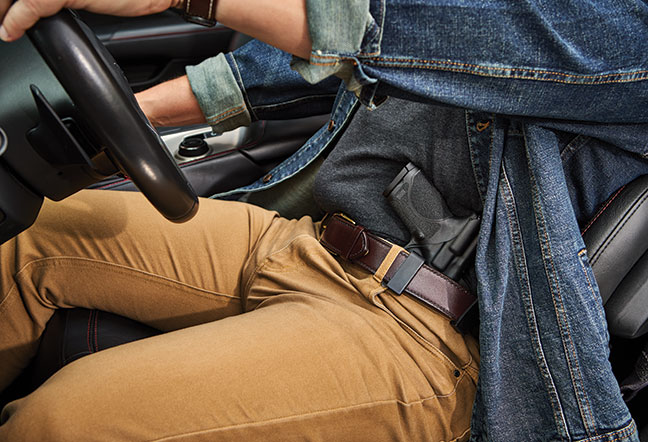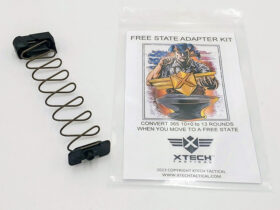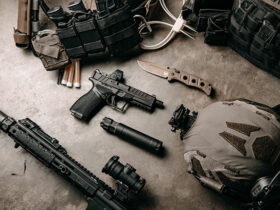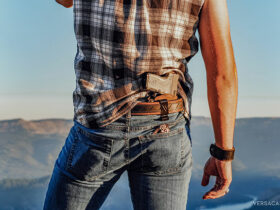When it comes to personal defense, some feel the average concealed carry permit holder doesn’t need the same gear as a professional. Maybe you don’t need the same load out, but your problem will be the same — stopping a deadly attack. You certainly need service-grade gear (at a minimum).
I like a forum of discussion, rather than being asked to write according to a certain line. Years ago, I successfully wrote for Law & Order and other police magazines — before they declined to a shadow of their former stature. The work had to be legally defensible and accurate. Here at The Shooter’s Log, we have a wide array of opinions represented.

Some put forth ideas that would not last long in an unfriendly environment, or if the writer actually carried a gun on a daily basis. Shooting well requires skill and drive. I believe in developing skill over apparatus maximums. Some pursue the reverse. Wouldn’t we be foolish to fail to apply a mix of skill, highly-developed firearms, and support gear?
I have developed training programs and written curriculum at the university level. (Please consider Sonora University’s gunsmith program.) My abstracts have been published at the Federal level. On a practical level, I served in blue for many years and shot in competition. I won and lost some. However, that was so long ago that my competitive experience is now irrelevant.
My degree is in Criminal Justice, while the minor study in Psychology has proven invaluable, but only because I maintained my study and practical application. I have survived a number of violent encounters having my face, hands, and one arm scarred, and a leg slightly impaired.
Today life is conflict-free, but I remain committed to preparation and training. I seek out the best information and gear possible. The reasons that we have conflict and violence have not changed for 1,000+ years. Tactics and weapons evolve. I am no Miyamoto Musashi, but his writings spoke of poor schools of thought and the same poor schools exist today. Tactics and gear must be conflict proven. You don’t have to live in the dojo or on the firing range, but you cannot be a stranger either.

Tools don’t make the shooter. The tools adopted by professionals are often high-quality and appropriate to the task. When it comes to load-bearing gear, speed, access, space, and organizational capability are important. Stick to fundaments and proven designs.
The design and execution, stitching, material, and final finish should be of high quality. A built-in sight track and reinforced holster mouth are essential. The holster must keep the firearm stabilized without slop on the belt. The supporting gun belt must be of good quality.
The presentation leads into the shooting stance and the handgun’s orientation to the threat. Five hundred repetitions are a reasonable beginning to properly mastering the draw. Increments of 5–10 repetitions a day are a good standard to maintain the edge. Smoothness and economy of motion are the basics to develop.

Speed comes with practice. The goal is to draw and present the firearm in 1.5–2.0 seconds, registering a center hit at seven yards. This isn’t out of the reach of anyone with average strength and dedication. I don’t recommend tuckable under-the-shirt holsters or ankle carry, as they cannot meet this standard. Ankle carry and pocket carry are acceptable for backup-gun carry under certain situations.
The goal isn’t to carry a handgun as comfortably as possible. Instead, it is to carry the handgun securely with quick access and a high degree of repeatability. The holster and belt combination must be secure at all times. Rebound is an aggravation that will adversely affect concealed carry.
The adversary has the advantage as he or she has planned the action. You must fight reaction time. If you have ever swerved or reacted to avoid an accident, you know reaction time can be very fast. Ever smacked a mosquito? That is reaction time.

Gunfights are similar to a car wreck. They come without warning. Reaction and training are everything. We are going to look at strong-side, inside the waistband, appendix, cross-draw, and shoulder holster carry.
Clothing Requirements: Belts and T-Shirts
A well-made double-stitched gun belt is an absolute requirement. A quality leather belt is my favorite. There are well-made fabric belts and ratchet-type belts as well. When wearing a holster under a pulled-out shirt, you must wear a T-shirt. This helps beat the heat.
A novice may never learn that a holster or gun butt rubbing against the body sometimes adheres to the body or gouges the skin. There is no compromise. Ignore the baseline and your concealed carry experience will not be profitable. A loose-fitting outer garment is essential. The trousers don’t matter as much so long as they have well-made belt loops that fit the gun belt well.
Strong-Side Belt Holsters
The strong-side holster is worn just behind the hip. Don’t wear it on the point of the hip or you will have a bulge. The scabbard, Avenger, or pancake style all work well. The holster should be sturdy and tilt the gun butt slightly forward. If the balance of speed and retention is done well, the holster need not use a safety strap.
If you think you can get by with a cheap, floppy, fabric holster with a retention strap, you will have speed, concealment, and retention difficulty. I prefer the Avenger type with its tunnel loop keeping the holster close to the body when the belt is tightened. A semi-pancake, like the Galco Combat Master, is easier to conceal and offers a sharp draw.
The draw is simple:
- Shoot the elbow to the rear.
- Bring the hand up from below the holster.
- Scoop the pistol from the holster.
Inside the Waistband
My daily carry is almost always an inside-the-waistband (IWB) holster. This holster rides inside the trousers between the body and the trousers. The holster may conceal the handgun with only the butt visible above the belt line. The handgun may be concealed more easily as the body of the holster and the handgun is concealed inside the waistband.

A lighter covering garment may be used to conceal the handgun. A light sport shirt or heavy T-shirt is well suited for IWB use. The holster attaches to the belt securely. Single or double attachment with a loop or belt clip may be used. The IWB holster must have a reinforced holster mouth to allow the handgun to be re-holstered after it has been drawn.
The draw is slightly more difficult than strong-side as the handgun is closer to the body. A genre of the IWB is the tuckable, which is worn like an IWB, and the shirt is worn over the holster. This is a slow draw. Tuckable holsters, however, are often excellent designs and may be worn simply as an IWB.
Appendix Carry
Appendix carry is very popular. I personally almost never use this carry mode. For some shooters and certain body types, appendix carry works well. Without a specifically designed holster, rollout is common. This is when the handgun butt rolls out from the body.

Some appendix holsters feature anti-rollout devices. These are simply feet or a claw at the bottom of the holster preventing rollout. The draw is simple, grasp the gun butt and pull straight up. For obvious reasons, you must not touch the trigger during the draw. Appendix carry has advantages similar to the cross-draw when seated.
Cross-Draw
The cross-draw holster is worn on the non-dominant side of the body. The best carry spot is in front of the hip. The muzzle is angled outward (slightly), and the grip is canted to allow a rapid draw. Most shooters get the cross-draw presentation wrong and make it ponderously slow.
If you stand squared to the target, reach across the body, and then bring the handgun to bear, you will be very slow. The muzzle will sweep across the body rather than into the opponent’s body — another tactical error.

The proper cross-draw presentation begins with the strong-side foot to the rear and the weak side (gun side) hip pointed toward the target. The strong-side hand moves at the elbow to grasp the gun butt. The handgun comes up out of the holster, is raised to eye level, and is pushed straight toward the target as the support hand meets the strong-side hand.
When properly executed, and the handgun is brought up instead of across during the draw, the presentation from cross-draw carry is fast and sharp. If you don’t hit the center of the target, you still have a broad strike zone top to bottom of six feet or a little less with most threats. With the wrong draw, the likely zone is a couple of feet across.
Cross-draw is an excellent choice for those who are seated during most of the day. Cross-draw is a good choice for those with damaged rotator cuffs. With cross-draw, you do not have to flex the shoulder by reaching backward.
A concealed cross-draw holster may be defended against a gun grab by dropping the left arm over the holster. A caution, there are a number of terrible cross-draw holsters. Choose a quality example with the proper draw angle. Never simply place a strong-side holster on the ‘wrong side.’ Purchase a purpose-designed cross-draw holster.
Shoulder Holsters
Shoulder holsters, in common with the cross-draw, should only be chosen based on good quality. Adjustment isn’t easy and the holster must not rebound during movement. The holster must be secure.

A shoulder holster gets the handgun and spare magazines off the belt and may be beneficial to those with strained back muscles. The shoulder holster demands a covering garment thick enough to prevent printing or being visible beneath the garment. Some shooters find the shoulder holster restricting and uncomfortable. The shoulder holster is a viable option but must be carefully studied before adoption. A shoulder holster may be concealed by a short covering garment with good results.
The shoulder holster draw depends upon whether you have chosen a vertical or horizontal design. The vertical shoulder holster demands the handgun to be drawn up, the wrist is twisted, and the pistol presented to the target. The horizontal holster conceals a shorter handgun more easily and the draw may be a bit sharper. Don’t choose the shoulder holster based on bling but on real utility.
Presented are the five carry positions that are most used, most viable, and most useful. Consider your needs and dedication when choosing a holster and carry position. Begin with the strong side holster, and work your options from there. What are your favorite carry positions and why? Share your answers in the comment section.
Editor’s note: This post was originally published in October of 2022. It has been completely revamped and updated for accuracy and clarity.










Leave a Reply